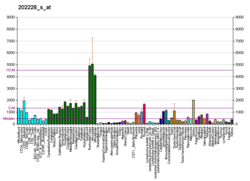Neuroplastin is a protein that in humans is encoded by the NPTN gene.
Neuroplastin is a type I transmembrane protein belonging to the Ig superfamily. The protein is believed to be involved in cell-cell interactions or cell-substrate interactions. The alpha and beta transcripts show differential localization within the brain.
In 2014, in a study led by Dr. Sylvane Desrivières, of King's College London's Institute of Psychiatry found that "teenagers who had a highly functioning NPTN gene performed better in intelligence tests"
References
- ^ GRCh38: Ensembl release 89: ENSG00000156642 – Ensembl, May 2017
- ^ GRCm38: Ensembl release 89: ENSMUSG00000032336 – Ensembl, May 2017
- "Human PubMed Reference:". National Center for Biotechnology Information, U.S. National Library of Medicine.
- "Mouse PubMed Reference:". National Center for Biotechnology Information, U.S. National Library of Medicine.
- Andersson B, Wentland MA, Ricafrente JY, Liu W, Gibbs RA (June 1996). "A "double adaptor" method for improved shotgun library construction". Anal Biochem. 236 (1): 107–13. doi:10.1006/abio.1996.0138. PMID 8619474.
- Yu W, Andersson B, Worley KC, Muzny DM, Ding Y, Liu W, Ricafrente JY, Wentland MA, Lennon G, Gibbs RA (June 1997). "Large-scale concatenation cDNA sequencing". Genome Res. 7 (4): 353–8. doi:10.1101/gr.7.4.353. PMC 139146. PMID 9110174.
- ^ "Entrez Gene: NPTN neuroplastin".
- Is intelligence written in the genes?
- Researchers Find Gene that Links Grey Matter with Intelligence
- Single nucleotide polymorphism in the neuroplastin locus associates with cortical thickness and intellectual ability in adolescents
Further reading
- Langnaese K, Beesley PW, Gundelfinger ED (1997). "Synaptic membrane glycoproteins gp65 and gp55 are new members of the immunoglobulin superfamily". J. Biol. Chem. 272 (2): 821–7. doi:10.1074/jbc.272.2.821. PMID 8995369.
- Strausberg RL, Feingold EA, Grouse LH, et al. (2003). "Generation and initial analysis of more than 15,000 full-length human and mouse cDNA sequences". Proc. Natl. Acad. Sci. U.S.A. 99 (26): 16899–903. Bibcode:2002PNAS...9916899M. doi:10.1073/pnas.242603899. PMC 139241. PMID 12477932.
- Brandenberger R, Wei H, Zhang S, et al. (2005). "Transcriptome characterization elucidates signaling networks that control human ES cell growth and differentiation". Nat. Biotechnol. 22 (6): 707–16. doi:10.1038/nbt971. PMID 15146197. S2CID 27764390.
- Zhang Z, Henzel WJ (2005). "Signal peptide prediction based on analysis of experimentally verified cleavage sites". Protein Sci. 13 (10): 2819–24. doi:10.1110/ps.04682504. PMC 2286551. PMID 15340161.
- Gerhard DS, Wagner L, Feingold EA, et al. (2004). "The status, quality, and expansion of the NIH full-length cDNA project: the Mammalian Gene Collection (MGC)". Genome Res. 14 (10B): 2121–7. doi:10.1101/gr.2596504. PMC 528928. PMID 15489334.
- Saito A, Fujikura-Ouchi Y, Kuramasu A, et al. (2007). "Association study of putative promoter polymorphisms in the neuroplastin gene and schizophrenia". Neurosci. Lett. 411 (3): 168–73. doi:10.1016/j.neulet.2006.08.042. PMID 17123723. S2CID 36492996.
- Bernstein HG, Smalla KH, Bogerts B, et al. (2007). "The immunolocalization of the synaptic glycoprotein neuroplastin differs substantially between the human and the rodent brain". Brain Res. 1134 (1): 107–12. doi:10.1016/j.brainres.2006.11.090. PMID 17196182. S2CID 31095277.
This article on a gene on human chromosome 15 is a stub. You can help Misplaced Pages by expanding it. |




